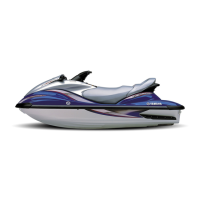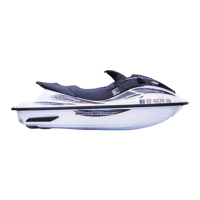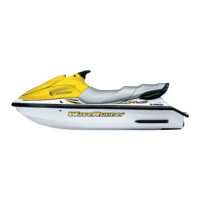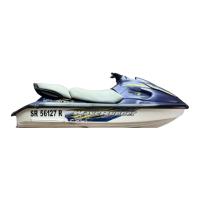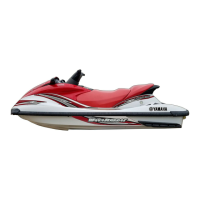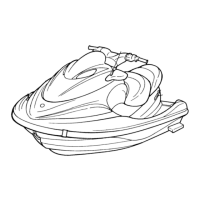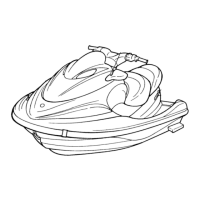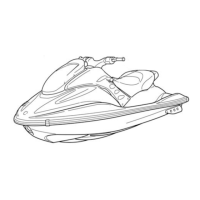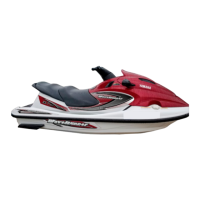Do you have a question about the Yamaha 2009 Wave Runner and is the answer not in the manual?
Details on PRI-ID, Hull Identification Number (HIN), and engine serial numbers.
Information on emission control compliance and its certificate label.
Location of the label indicating the manufacturing date of the watercraft.
Diagram showing the locations of various important labels on the watercraft.
Key safety warnings for operating the watercraft, including PFD use and riding limits.
Details on specific labels related to reverse operation, fire extinguisher, and capacity.
Specifies minimum operator age, supervision, and maximum passenger/load limits.
Guidelines on operating conditions, visibility, weather, and water depth.
Details on mandatory PFDs, protective clothing, eye protection, and optional helmets.
Lists essential safety gear like signaling devices, distress signals, and towlines.
Warns about exhaust fumes, hot surfaces, and general operating hazards.
Explains jet thrust steering, Off-Throttle Steering (OTS), and lack of neutral gear.
Safety procedures and considerations for water-skiing with the watercraft.
Emphasizes adherence to boating laws and responsible operation on waterways.
Promotes respectful operation towards others, nature, and proper maintenance.
Diagram identifying key external components of the watercraft from the front.
Diagram identifying key external components of the watercraft from the rear.
Details the various controls and switches on the handlebars and steering column.
Illustrations and identification of components found within the engine compartment.
Instructions on how to remove, install, and operate the seat and hood.
Procedure for removing and installing the fuel tank filler cap.
Details on the remote transmitter for security and mode settings.
How to use the engine stop switch to halt the engine normally.
Explanation of how to attach and use the engine shut-off cord for safety.
Instructions on how to use the start switch to engage the engine.
How to use the throttle lever to control engine speed and acceleration.
Description of the cooling water pilot outlet and its function.
Explains how handlebars control the jet thrust nozzle for steering.
Details on operating the shift lever for forward and reverse movement.
Information on the handgrip's purpose and warnings against using it for lifting.
Instructions for using the reboarding step and its limitations.
Describes the purpose of the bow eye for towing and mooring.
Identifies the stern eyes used for towing and mooring.
Overview of the integrated system controlling engine functions and steering.
Explanation of the security system for preventing theft and unauthorized use.
How to select lock/unlock modes using the remote control transmitter.
Information on the front and glove compartments, including capacity and load limits.
Details the location, capacity, load limit, and operation of the front storage compartment.
Details the location, capacity, load limit, and operation of the glove compartment.
Recommended fuel, octane ratings, and safe refueling practices.
List of essential checks before launching and operating the watercraft.
Detailed checks for engine compartment, hull, fuel, oil, and battery.
Guidance on the initial break-in period for the engine to ensure longevity.
Steps and precautions for safely launching the watercraft into the water.
Instructions for starting the engine, including security system and safety checks.
How to safely stop the engine using the stop switch or shut-off cord.
Instructions for shifting between forward and reverse gears.
Steps for securing the watercraft when leaving it unattended.
Introduction to basic operation, safety reading, and load limits.
Advice on practice, checking laws, and developing riding skills before operation.
Guidelines for safely carrying passengers, including seating and holding instructions.
Key collision avoidance steps and throttle usage advice before starting.
Procedures for boarding and starting in shallow water, including depth requirements.
Steps for boarding and starting the watercraft when docked.
Guidance for boarding and starting in deep water, emphasizing practice.
Instructions for safely boarding the watercraft by oneself.
Safe boarding procedures when passengers are involved, considering weight limits.
Steps for safely righting a capsized watercraft and preventing injury or damage.
Techniques for turning, including throttle use and effects of speed on turning.
Explanation of how the watercraft stops, including stopping distance.
Procedures for safely bringing the watercraft to shore and stopping the engine.
Steps for approaching and docking the watercraft safely.
Using the reverse function for slow-speed maneuvering and backing up.
Advice on operating in areas with thick weed growth to avoid clogging.
Steps for removing from water, washing, draining, and preparing for storage.
Guidelines for securing the watercraft on a trailer for safe transport.
Proper upright positioning and procedures for storing the watercraft.
Instructions for lubricating cables and specific points for smooth operation.
Procedures for removing, storing, checking, and charging the battery.
Steps for cleaning the hull, engine compartment, and components.
Importance of periodic checks, adjustments, and using genuine parts.
Advice on carrying the manual and tool kit for maintenance and repairs.
Chart outlining recommended maintenance intervals for various components.
Procedures for checking fuel tank, hoses, and system for leaks and contamination.
Checking the fuel tank for leaks, water, and dirt.
Details on recommended oil, quantity, and recommended dealer service for oil changes.
Recommendation to have the air filter element checked at specified intervals.
Checking the steering system for proper operation and nozzle alignment.
Verifying the shift cable and reverse gate contact with the stopper.
Procedure for checking throttle cable return and adjusting free play.
Instructions for removing, cleaning, adjusting, and installing spark plugs.
Identifying specific points needing lubrication for optimal performance.
Detailed guide on checking electrolyte, tightening leads, and general battery care.
Recommendation for dealer service if the fuel injection system malfunctions.
Procedure for checking and ensuring the engine idles at the correct trolling speed.
Details on passenger capacity, load limits, and physical dimensions of the watercraft.
Information on fuel consumption, cruising range, and trolling speed.
Technical details of the engine, including type, displacement, bore, stroke, and compression.
Details on the ignition system, spark plug type, and gap.
Information on the propulsion system, jet pump type, and nozzle angle.
Recommended fuel, octane ratings, oil types, quantities, and tank capacity.
A chart listing common troubles, possible causes, remedies, and page references.
Steps to take in emergency situations like cleaning jet intake or dealing with a capsized craft.
Procedure for removing weeds or debris from the jet intake and impeller.
Instructions for starting the engine using a booster battery and jumper cables.
Steps for identifying and replacing blown fuses safely.
Guidelines for safely towing an inoperative watercraft.
Steps to take if the watercraft is submerged or flooded with water.
Details on PRI-ID, Hull Identification Number (HIN), and engine serial numbers.
Information on emission control compliance and its certificate label.
Location of the label indicating the manufacturing date of the watercraft.
Diagram showing the locations of various important labels on the watercraft.
Key safety warnings for operating the watercraft, including PFD use and riding limits.
Details on specific labels related to reverse operation, fire extinguisher, and capacity.
Specifies minimum operator age, supervision, and maximum passenger/load limits.
Guidelines on operating conditions, visibility, weather, and water depth.
Details on mandatory PFDs, protective clothing, eye protection, and optional helmets.
Lists essential safety gear like signaling devices, distress signals, and towlines.
Warns about exhaust fumes, hot surfaces, and general operating hazards.
Explains jet thrust steering, Off-Throttle Steering (OTS), and lack of neutral gear.
Safety procedures and considerations for water-skiing with the watercraft.
Emphasizes adherence to boating laws and responsible operation on waterways.
Promotes respectful operation towards others, nature, and proper maintenance.
Diagram identifying key external components of the watercraft from the front.
Diagram identifying key external components of the watercraft from the rear.
Details the various controls and switches on the handlebars and steering column.
Illustrations and identification of components found within the engine compartment.
Instructions on how to remove, install, and operate the seat and hood.
Procedure for removing and installing the fuel tank filler cap.
Details on the remote transmitter for security and mode settings.
How to use the engine stop switch to halt the engine normally.
Explanation of how to attach and use the engine shut-off cord for safety.
Instructions on how to use the start switch to engage the engine.
How to use the throttle lever to control engine speed and acceleration.
Description of the cooling water pilot outlet and its function.
Explains how handlebars control the jet thrust nozzle for steering.
Details on operating the shift lever for forward and reverse movement.
Information on the handgrip's purpose and warnings against using it for lifting.
Instructions for using the reboarding step and its limitations.
Describes the purpose of the bow eye for towing and mooring.
Identifies the stern eyes used for towing and mooring.
Overview of the integrated system controlling engine functions and steering.
Explanation of the security system for preventing theft and unauthorized use.
How to select lock/unlock modes using the remote control transmitter.
Information on the front and glove compartments, including capacity and load limits.
Details the location, capacity, load limit, and operation of the front storage compartment.
Details the location, capacity, load limit, and operation of the glove compartment.
Recommended fuel, octane ratings, and safe refueling practices.
List of essential checks before launching and operating the watercraft.
Detailed checks for engine compartment, hull, fuel, oil, and battery.
Guidance on the initial break-in period for the engine to ensure longevity.
Steps and precautions for safely launching the watercraft into the water.
Instructions for starting the engine, including security system and safety checks.
How to safely stop the engine using the stop switch or shut-off cord.
Instructions for shifting between forward and reverse gears.
Steps for securing the watercraft when leaving it unattended.
Introduction to basic operation, safety reading, and load limits.
Advice on practice, checking laws, and developing riding skills before operation.
Guidelines for safely carrying passengers, including seating and holding instructions.
Key collision avoidance steps and throttle usage advice before starting.
Procedures for boarding and starting in shallow water, including depth requirements.
Steps for boarding and starting the watercraft when docked.
Guidance for boarding and starting in deep water, emphasizing practice.
Instructions for safely boarding the watercraft by oneself.
Safe boarding procedures when passengers are involved, considering weight limits.
Steps for safely righting a capsized watercraft and preventing injury or damage.
Techniques for turning, including throttle use and effects of speed on turning.
Explanation of how the watercraft stops, including stopping distance.
Procedures for safely bringing the watercraft to shore and stopping the engine.
Steps for approaching and docking the watercraft safely.
Using the reverse function for slow-speed maneuvering and backing up.
Advice on operating in areas with thick weed growth to avoid clogging.
Steps for removing from water, washing, draining, and preparing for storage.
Guidelines for securing the watercraft on a trailer for safe transport.
Proper upright positioning and procedures for storing the watercraft.
Instructions for lubricating cables and specific points for smooth operation.
Procedures for removing, storing, checking, and charging the battery.
Steps for cleaning the hull, engine compartment, and components.
Importance of periodic checks, adjustments, and using genuine parts.
Advice on carrying the manual and tool kit for maintenance and repairs.
Chart outlining recommended maintenance intervals for various components.
Procedures for checking fuel tank, hoses, and system for leaks and contamination.
Checking the fuel tank for leaks, water, and dirt.
Details on recommended oil, quantity, and recommended dealer service for oil changes.
Recommendation to have the air filter element checked at specified intervals.
Checking the steering system for proper operation and nozzle alignment.
Verifying the shift cable and reverse gate contact with the stopper.
Procedure for checking throttle cable return and adjusting free play.
Instructions for removing, cleaning, adjusting, and installing spark plugs.
Identifying specific points needing lubrication for optimal performance.
Detailed guide on checking electrolyte, tightening leads, and general battery care.
Recommendation for dealer service if the fuel injection system malfunctions.
Procedure for checking and ensuring the engine idles at the correct trolling speed.
Details on passenger capacity, load limits, and physical dimensions of the watercraft.
Information on fuel consumption, cruising range, and trolling speed.
Technical details of the engine, including type, displacement, bore, stroke, and compression.
Details on the ignition system, spark plug type, and gap.
Information on the propulsion system, jet pump type, and nozzle angle.
Recommended fuel, octane ratings, oil types, quantities, and tank capacity.
A chart listing common troubles, possible causes, remedies, and page references.
Steps to take in emergency situations like cleaning jet intake or dealing with a capsized craft.
Procedure for removing weeds or debris from the jet intake and impeller.
Instructions for starting the engine using a booster battery and jumper cables.
Steps for identifying and replacing blown fuses safely.
Guidelines for safely towing an inoperative watercraft.
Steps to take if the watercraft is submerged or flooded with water.
| Model | WaveRunner |
|---|---|
| Year | 2009 |
| Manufacturer | Yamaha |
| Engine Displacement | 1052cc |
| Horsepower | 110 hp |
| Fuel Capacity | 18.5 gallons |
| Passenger Capacity | 3 |
| Engine Type | 4-stroke |



